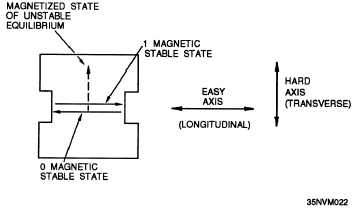of the core(s) to zero. If the core(s) had been in the one
state, the sense line would pick up the change in flux
direction from one to zero and indicate that a one had
been stored in the core. At the completion of the read
operation, the core or cores addressed are left in the zero
state (three or four wire). The contents of the cores
sensed by the read current would be temporarily stored
in a register. This process of reading cores to the zero
state is known as a destructive readout. Data read
from cores must be temporarily saved in a register and
then immediately written back into the cores (restored).
The destructive readout of data from cores necessitates
the completion of the storage or memory cycle.
WRITE (RESTORE) CYCLE.— New data or the
data read from core must be written (or written back)
into the cores for permanent storage. This portion of
the storage cycle is known as the write or restore
operation. Each storage cycle consists of a read and
then a write or restore operation. Other terms
commonly used are the read and write half-cycles.
During the write or restore operation, write current is
applied to the drive lines of the core or cores addressed.
Write current is designed to change the state of a core
from zero to one. Remember at this time all the selected
cores are in the zero state from the read operation.
For the four-wire cores that are to store zeros,
inhibit current is applied through the inhibit line in
opposition to the write current. The inhibit current
prevents the changing of the core(s) from zero to one.
Three-wire cores change to the ONE state only if
both digit and word lines carry write current. Current
in the digit line is dependent on the binary bit to be
stored. The word line carries write current during the
write operation. When the bit to be stored is a zero, no
write current is applied to the digit line. Write current
in the word line only will not change the state of
the core to one.
When a one is to be stored, write
current is applied to the digit line, and when combined
with the word line current, changes the state of the core
to one.
During the write or restore operation, all selected
cores that are to store a one are written to the one state.
All selected cores that are to store a zero will be in-
hibited from writing a one by the inhibit current in the
four-wire cores and left in the zero state. Lack of digit
write current will leave three-wire cores in the zero state.
READ/WRITE CIRCUITS.— Two important
circuits used during the read/write cycle include the
inhibit current regulator and sense amplifiers.
Inhibit Current Regulator.— The inhibit current
regulator circuits are enabled only during a write cycle
when there is zero in the corresponding bit of the
interface register. The resulting inhibit current pulse
prevents a one from being written into the associated
bit position at the address selected.
Sense Amplifiers.— The sense amplifiers sense the
state of the cores selected during a read operation. The
sense amplifiers are disabled during a write cycle, and
enable the sense amplifier strobe during a read cycle.
Data read by the sense amplifiers is transferred into the
interface register until it can be restored back into core
memory.
FILM MEMORY
Film memory is the other primary storage medium
of digital computers.
It is used primarily on large
mainframes.
Depending on the mainframe, film
memory is contained in memory modules; usually four
large memory modules to a mainframe computer set.
Film Architecture
Magnetic film storage is composed of hundreds of
thousands of very small “I”-shaped magnetic thin film
spots. Figure 6-14 is an example of one film spot and
Figure 6-14.—Bistab1e nature in thin film spots.
6-13


